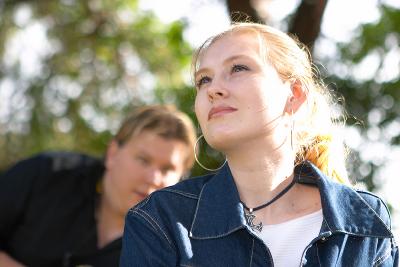lrrp77 said:
Let's say that you are taking a shot of a person but he is backlit by the bright sun, i.e. the sunlight is shining directly into your lens. [...] What settings, filters, flash should I use to avoid silouetting the person & to see his face clearly.
This is slightly tricky, but read what I say closely and hopefully you will understand.
The first thing you do is compose your picture properly. When the sun is shining directly into your lens, you will have problems with flare (little octagons in your frame) and halation (overall decrease in contrast). You can see this in your viewfinder. Make sure you use a lens hood, or change your composition so that the flare/halation disappears (unless of course you WANT this effect).
The next thing you do is to decide how to expose the picture properly. This is the trickiest bit. You can either do it the manual way, or the automatic way. If you want to do it the automatic way, you have to understand how your camera's TTL metering works and dial in the appropriate amount of flash exposure compensation. However, you need to understand the
principle behind fill flash, so I will describe how you do it the manual way:
First is a bit of background knowledge. Suppose your film (or sensor) has a 6 stop latitude:
(Blk)---(-2)---(-1)---(Mid)---(+1)---(+2)---(Wht)
Therefore, anything more than 3 stops either side of (mid) will cause blowout or blackout. You need to look at your picture closely and ask yourself what you will allow to blow out or black out. So the first step in exposure is to
choose your midtone and this is how you do it:
1. Meter your subject. Either use the spot meter on your camera, or use an incident meter (place on his face, pointing back towards the camera). Let's say this is F/8, 1/125s at ISO 100.
2. Meter your background. Point your incident meter back towards the background and take a reading. Or, set your camera to matrix metering and point it at the background. Let's say this is F/16, 1/125s, at ISO 100.
3. Set your camera in manual mode, and enter F/16, 1/125s if you are shooting ISO 100 film. Your midtone has now been entered into the camera.
The next thing you need to do is decide how you are going to compensate:
4. You realize there is a 2 stop difference between the subject and the background (F/8, F/11, F/16). If you take a picture without fill flash, your subject's face will be two stops darker than the background, so therefore you need to throw two stops of light on his face to bring it back up.
5. Option 1: use fill flash. Use an incident meter set to "flash" mode. Fire your flash. Adjust your flash power output until your meter gives you F/16, 1/125s at ISO 100.
Note: you CAN use TTL to automate this but I personally find the results too unpredictable. You need to understand how your TTL works before you start getting reliable results. You could go to the photonotes website and read their article on
EOS flash to get a better understanding. If you shoot Nikon, then ask a Nikon expert.
6. Option 2: use a reflector. Get an assistant to point a reflector at the subject, and take an meter reading until you get F/16.
7. Take the picture!
lrrp77 said:
If there is a mirror behind your subject in an indoor environment. How should I avoid a flash reflection.
By composing your picture properly! If you can see yourself in the mirror then you will get a flash reflection.




